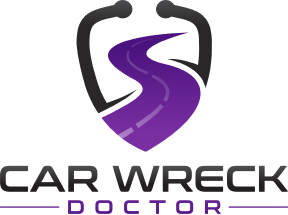There's a good chance you're going to be in a car accident.
In the U.S., there are about six million accidents every year, and that's not including the accidents that aren't being reported.
So, if you haven't yet, the likelihood of you being in a car accident is fairly high.
But, not to worry, not all car accidents involved cars flipping on their hoods, massive explosions, and multi-car pileups like we see in the movies.
A good bit of those car accidents are minor things like hitting a mailbox, driving off the road into a ditch, and small fender benders. Nothing that should be keeping you up at night.
However, injuries can still occur in even the most minor accidents.
Whiplash is one of the most common injuries people sustain when they're involved in an accident.
It's also an injury that most people don't even realize they have and don't seek treatment for until the pain gets unbearable.
By that time, you may have already developed complications related to the injury.
That's why it's very important to seek out medical attention after any car accident you're involved in and know what to do for whiplash after your accident.
It's vital to get the treatment you need for whiplash as soon as possible and know what self-care steps you should be taking. Recovery time from whiplash may take a while.
In the article below, we'll dive deeper into whiplash, and learn what the best treatment options are.
You may be wondering, what good can treatment do? Read our blog post: "Can a Doctor Really Help with Whiplash?"
Table Of Contents
- What Is Whiplash
- How Does Whiplash Occur
- What Are The Symptoms Of Whiplash?
- The Best Ways To Treat Your Whiplash
- Pain Management
- Exercise
- Physical Therapy
- Chiropractic Care
- Whiplash Is A Serious Injury
What Is Whiplash?
Whiplash occurs when a person's head moves backward and then forward suddenly and with great force.
This is a very common injury following a rear end collision because of the impact on your car.
Apart from car accidents, whiplash can also occur from physical abuse, sport injuries, and even amusement park rides.
Whiplash results when the soft tissues (muscle and ligaments) of your neck extend beyond their typical range of motion.
Your symptoms might not appear for a while, so it's important to pay attention to any physical changes for a few days following any kind of accident or injury.
Typically, whiplash is a relatively mild condition, but if left untreated it can cause other complications, long-term pain, and discomfort.
How Does Whiplash Occur?
Any time your neck undergoes rapid movement backward and then forward, you will likely suffer from whiplash.
The sudden motion causes your tendons and ligaments to stretch or even tear, resulting in whiplash.
Some events that can cause whiplash include:
- Car accidents
- Physical abuse
- Contact sports
- Horseback riding
- Cycling accidents
- Slips and falls
- Blows to the head

What Are The Symptoms Of Whiplash?
Symptoms don't always appear immediately, but they will usually start to show themselves within 24 hours of the accident occurring.
Sometimes they can take a few days to develop, but no matter when you notice them, they can last for several weeks.
If you notice any of these symptoms or a combination of them, there's a possibility you have whiplash:
- Neck pain and stiffness
- Headaches at the base of the skull
- Dizziness
- Blurred vision
- Constant weariness
Less common symptoms can include problems with your concentration and memory, ringing in the ears, an inability to sleep well, irritability, and chronic pain in your neck, shoulders, or head.
You should see a chiropractor if you're experiencing any of those symptoms so they can work out a treatment plan for you.
However, it's critical that you see a doctor immediately if any symptoms spread to your shoulders or arms, it becomes painful to move your head, and/or you have numbness or weakness in your arms.
The Best Ways To Treat Your Whiplash
When you begin treatment for whiplash, the goals are to control the pain, restore the normal range of motion in your neck, and return you to your normal activities as soon as possible.
The treatment plan your chiropractor comes up with will depend on the severity of your injury.
Some people on need to take a quick trip to the pharmacy and complete some at-home care.
Others might need a more intense treatment plan including several visits to their chiropractor, specialized pain treatment, or physical therapy.
Pain Management
If your pain is too intense to handle on your own, there are several things your doctor or chiropractor is likely to recommend.
- Rest Rest can be extremely helpful during the first 24 hours following your injury, but too much rest can actually delay your recovery.
- Heat or Cold Therapies Either heat or cold applied to the neck for 15 minutes up to six times a day can ease the pain and help you feel better.
- Over-the-Counter Pain Medications OTC pain relievers, like Tylenol and Advil , will often control mild to moderate whiplash pain.
- Prescription Medications Chiropractors like to avoid prescription medications as often as possible, but sometimes they are necessary to get some quick relief. People with more severe pain may benefit with treatment combined with certain prescription pain killers shown to relieve nerve pain.
Exercise
Your chiropractor can recommend several stretching and mobility exercises that will help restore the range of motion in your neck and get you back to your normal routine.
- Some of these exercises are:
- Neck rotations
- Tilting your head from side to side
- Putting your chin on your chest
- Rolling your shoulders
Before you being these exercises, it's a good idea to apply moist heat to the painful area or take a warm shower to help ease the pain.
Physical Therapy
Physical therapy can help you feel better and can even prevent further injury.
Your physical therapist will guide you through exercises to strengthen your muscles, improve posture, and restore your normal movement.
The amount of physical therapy that's needed will vary from person to person and depends largely on the severity of the injury.

Chiropractic Care
Chiropractic care is an excellent choice when it comes to treatments for whiplash.
The treatment plan your chiropractor comes up with will depend on the severity of your injury.
By using several different techniques, your chiropractor can assist in relieving pain, and encouraging healing in the areas affected by the whiplash.
- Chiropractic Adjustment With spinal manipulation and short thrusts or slower movements, your chiropractor can gently move the involved joint towards the restricted area. This helps create mobility and encourages healing.
- Muscle Relaxation and Muscle Stimulation With calm gentle stretches to the affected muscles, your chiropractor can relieve built up tension. Sometimes these stretches are also combined with 'finger pressure techniques' on certain pressure points to relieve pain.
- McKenzie Exercises McKenzie exercises are intended to reduce disc derangement caused by whiplash. The first set of exercises happen in your chiropractor's office, but they can be taught so you can use them at home. This gives you more control in the healing process.
Whiplash Is A Serious Injury
No matter how severe your accident, you should always seek medical attention.
It could take hours, days, or even weeks for symptoms to occur, but they should be treated immediately.
Going without treatment could lead to other complications, making things much worse for you.
Visiting your chiropractor after an accident is the best way to get your whiplash diagnosed and treated.
If you don't have a chiropractor, the folks at the Car Wreck Doctor can get you set up with one right away.
Just click the button below to get started.

